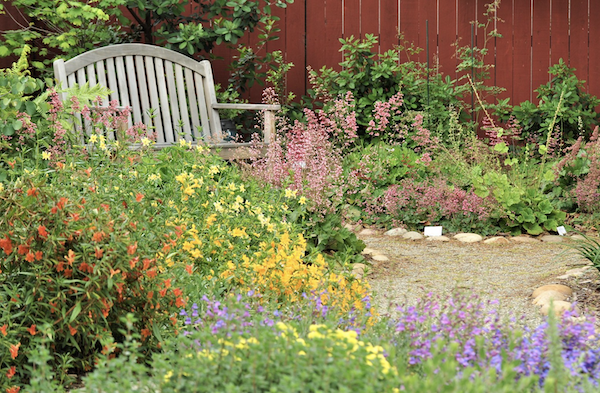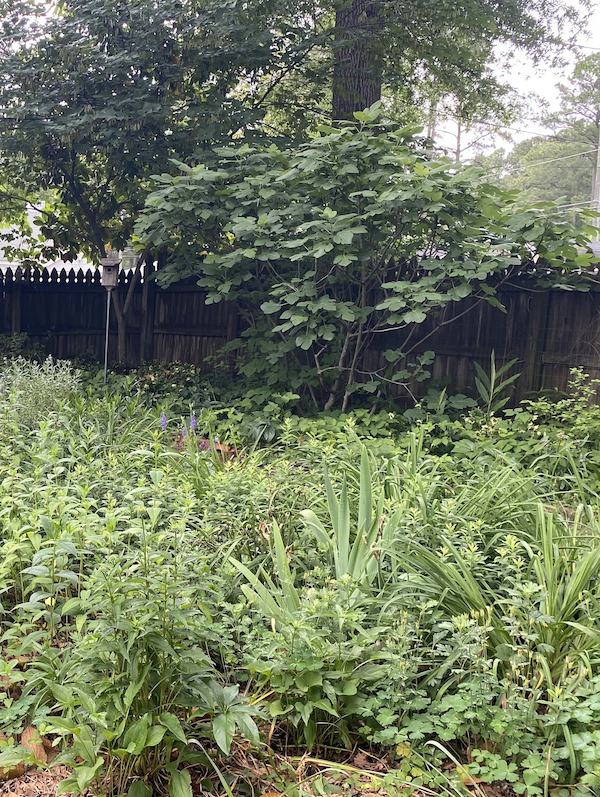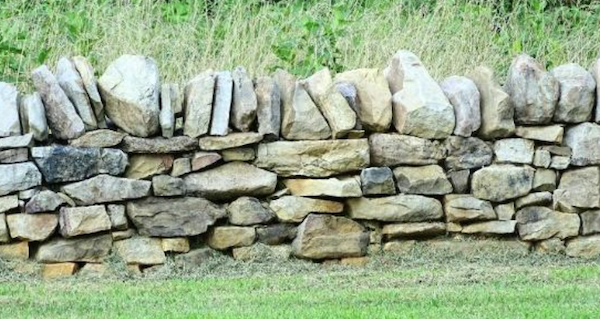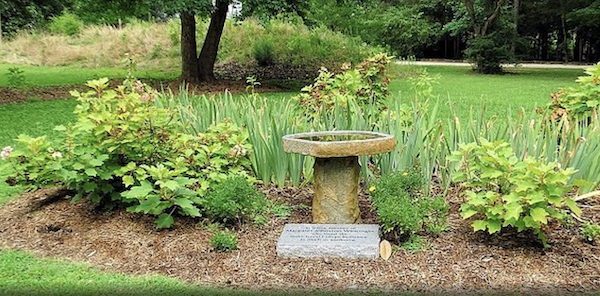Guest Blog: How to Launch a Wildlife Habitat in Your Backyard

DIY Backyard Wildlife Habitat
Guest blog by Kate Gavaghan, Sci In The Tri founder, writer and editor, and member of North Carolina Wildlife Federation’s Neuse River Hawks Community Wildlife Chapter.
Early summer is especially beautiful here in Wake Forest, as our streets and parks come alive with vibrant greenery and colorful blooms. And the hottest trend in green space design–gardening for pollinators and other wildlife–is very much on display.
From our parks to front yards to historic sites, there’s a visible shift away from cultivated hybrids that look pretty (but don’t do much else) to plants that are both beautiful and help nourish butterflies, native bees, songbirds, and other species.
Maybe you’ve admired these gardens and would like to start one yourself, but don’t know where to start. We’ve got you covered here with tips from local gardening pros. And if you don’t have the space (or time) for your own wildlife garden–no worries! We’ll also look at options for collaborating with local groups or your neighborhood.
Why Garden for Wildlife?
Our town, county and state have undergone enormous development over the past few decades. Gardening for wildlife aims to restore some native habitat that’s been lost to roads, homes, and commercial development. It puts back what’s been taken out: the native plants that provide food, water, shelter, and safe spaces to raise the next wild generation.
You might be thinking, “Well, doesn’t every plant provide some kind of food or shelter for nature?” Sadly, no!
During the heyday of suburban expansion, we went all in for hybrid trees, shrubs and flowers that were pleasing to humans (Fast-growing! Double blooms!) but didn’t produce food for wildlife. Growers actually developed plants that were unappealing to insects.
“That was one of the selling points,” explained Brenda Pate, current member (and past president) of the Wake Forest Garden Club. The bugs would stay away from your flowers. “But that’s a clue,” said Pate. If some part of the plant is not eaten (leaves, bark, seeds, fruits, pollen, nectar), “it’s not beneficial to nature.”
We also went a little crazy for exotic plants that became invasive here. The woodlands around Wake Forest now abound in Bradford pears, Brazilian verbena, Asian wisteria, Chinese privet, Japanese stilt grass, and English ivy, to name a few. Across the country, invasive plants have contributed to the decline of more than 40% of US native species, according to the US Forest Service.
“Nothing eats these plants,” said Herb Amyx, a volunteer with the Neuse River Hawks and one of the creators and maintainers of the wildlife garden at Forest Ridge Park. That’s one of the reasons they take over.
Decades of hybrids and exotics, combined with widespread pesticide use and land development, have led to shrinking food sources for wildlife. Studies of insect populations, including species critical for crop pollination, show significant declines. Not surprisingly, species that rely on insects for food (most birds, bats, and freshwater fish) are also in trouble. Long-term monitoring reveals that, since 1970, North America has lost 30% of its bird population.
So let’s get started! The good news is that awareness of these problems is growing. Even better–people are taking action. Here are the details on how to do it.
Think Through the Life Cycle
Check Out Your Surroundings
Identify Nutritional Holes
Your sleuthing will give you a good sense of the native habitat already available nearby. Maybe there’s a lack of native trees. Or maybe there are a couple of pollinator gardens, but they lack native grasses for over-wintering. Without a doubt, there will be nutritional holes you can fill or supplement. When I did this myself a few years ago, I discovered that, collectively, my neighbors and I had a nice mix of native trees: oaks, dogwoods, pines, hollies, tulip poplars and black cherries. Most native trees pull double duty, at least. Many flower early in spring, providing nectar and pollen to the earliest pollinators. Their leaves are tasty for hundreds of hungry caterpillars who will become butterflies, moths, or a meal for baby birds. Many produce fruits, nuts, or seeds for birds and small mammals. Lots of beneficial insects over-winter in their bark. It’s a long list of benefits, so I was glad to discover a nice variety nearby. But we had many nutritional holes, too. All the shrubs around our homes were sterile hybrids. We all grew some flowers, but not enough nutritious ones. There was also very little in the way of native grasses for overwintering. And we all had invasives, from Bradford pears to nandina to Japanese stilt grass.
Plug into Resources
Create Cycles and Ladders
Even with a small space (or a group of containers), you can provide year-long nutrition and shelter for pollinators and other wildlife. Just combine pollen and nectar plants with larval hosts and overwintering plants. Find A Plant can help you with this match-making exercise. For the damp, semi-shady location above, for example, you could combine an inkberry shrub (Ilex glabra), great blue lobelia (Lobelia siphilitica), white wood asters (Eurybia divaricata), golden alexander (Zizia aurea) and river oats (Chasmanthium latifolium). This mix will provide pollen and nectar through the spring, summer and fall; three of the plants are also larval hosts, and river oats provides habitat for bees and seeds for birds during the winter. Put this group under a native tree, and you’ll significantly boost the caterpillar population available for nesting baby birds. “Baby birds can’t eat seeds,” said Brenda Pate. “They need soft food.” And caterpillars are a mama bird’s first choice, being very high in protein and nutrients. Just one clutch of hatchlings needs 6,000 to 9,000 caterpillars to grow to adulthood.
The fledglings will also appreciate the “ladder” back up into the tree you’ve created by planting tall flowers and shrubs. “Fledgling birds just learning to fly can’t make it from the ground to the tree in one hop,” said Brenda Pate. “So creating these layers gives them a way up and down.”And it’s pretty! “You’re not sacrificing anything when you choose natives,” said Debbie Roos, creator of the NCSU Extension Service demonstration garden at Chatham Mills. “It’s not just the flowers in spring and summer,” she added. “Lots of the foliage is beautiful during the fall and winter seasons.
A Caution Against Re-Wilding
Maybe you’ve heard the term “re-wilding” and you’re thinking, “I’m just going to let my yard go back to nature.” Unfortunately, there are so many invasives in our area, you are likely to get a backyard full of Japanese stiltgrass and kudzu. Some natives may pop up voluntarily–perhaps oak, pine or dogwood seedlings. Nurture these along if you like but keep an eye out for the invading invasives as well. They show up often, and they don’t want to leave.
Where to Get Native Plants
Unfortunately, our big box stores (e.g., Home Depot, Lowes) are only slowly catching up to the native plant movement. But there are several excellent nurseries in our area focused on these plants. The organizations listed above all have links to them.
Sometimes you can find natives at the big box stores. But check the full (two-part) scientific name to be certain you are buying a native plant and not a cultivated hybrid. As an example, native wild yarrow is Achillea borealis. Yarrow is available at Lowe’s, but the tag just includes the genus name Achillea. The blooms on the Lowe’s yarrow are pretty big and fat. That’s a sign that the plant’s energy is probably going into producing flowers, not pollen and nectar. Pass on this guy if you’re looking for butterfly and bee food.
Big box stores can be a good source, though, for grass, sedge, and rushes–plants that are often lovely into the fall and winter, and that shelter native bees. “The cultivars at the big box stores are actually pretty close to the natives,” explained Amyx. Big box stores can also be a good source for pollinator-attracting herbs, like dill, parsley, and fennel.
Keep a Record
It’s a good idea to keep a record of the plants you add to your space; perhaps make a sketch of the layout as well. Nothing fancy–just something to help you remember where everything is. I also keep track of a plant’s origins–you might find you prefer plants from one nursery over another.
Add Water, Wood, and Rocks
Water, of course, is critical for wildlife. Even if you don’t plant a thing, you can help birds, butterflies, and bees with a simple watering station–just a dish with some pebbles for landing. This is especially helpful when our summer temperatures climb. Freshen the water at least every five days to keep mosquito larvae from hatching.
Our wild bees build solitary nests in the ground, or in cavities in dead logs or stems. Incorporate some of this into your garden! Leave out an old log or two or make a simple brush pile with sticks and stems. You can do something similar with rocks, making a simple pile at the edge of your property. Adding some native grasses will make it an attractive focal point and a year-round native bee haven.
Even if you don’t plant a single seed, one of the best things you can do for wildlife is kick the chemicals out of your yard. Pesticides, of course, are the most harmful agents here and would be completely counter-productive in a pollinator garden. But studies show that weed killers like Roundup are also damaging to wildlife. This year, check out some non-toxic alternatives for weed control or limit their use to invasives that creep into your space.
You Don’t Have To Go It Alone
Gardening for wildlife is a super cool and growing trend, but perhaps it’s not feasible for you right now. Maybe you don’t have a yard or the time. Only about 60% of Americans live in detached homes, and housing trends are moving towards denser, less land-intensive developments (this is a good thing for nature and energy conservation, actually).
There are still lots of ways for you to get your hands dirty, nourish nature, and learn from the pros. Local clubs, HOAs and nonprofits are taking an “all together now” approach to creating beautiful spaces that support nature.
Neighborhood HOAs and Garden Committees
Jennifer Gambino downsized to one of Wake Forest’s newer townhome neighborhoods and is helping her HOA and garden committee establish a couple of pollinator and wildlife gardens. “One of the misconceptions is that, aesthetically, you’re going to lose something,” said Gambino. But some research and a “field trip” or two showed the committee that native plants could be beautiful.
“If you’re using native plants,” she said, “you’re just talking about getting them established in the first year.” Because most are perennials, they come back. And they require less water and fertilizer.
Gambino’s neighborhood is looking at combining social activities with garden projects. “Lots of people who live here had houses for years, and we have lots of knowledge,” she said. A group garden is one way to bring that all together. People get to know each other and contribute in a positive way, she added.
My own neighborhood revamped its entryway last summer to focus on native pollinating plants. Different folks signed up for watering gigs, and this summer, instead of thirsty annuals, our neighborhood has a crop of wild indigo, asters, assorted milkweed, and purple coneflower. No watering required, and plenty of pollinators catching a meal. Perhaps there’s a similar option for your neighborhood.
Wake Forest Garden Club
The Wake Forest Garden Club, founded in 1924, is the “longest continuing community service organization” in our town. The Club supports several public projects, including the gardens at the Wake Forest Historical Museum, Miller Park at Elm Street, and the Main Street median. They annually prepare and deliver “milk crate” patio gardens to Tri-Area Ministry Food Pantry clients, and share their knowledge at community events.
In recent years, the Garden Club has embraced using native plants in their projects, even amending their bylaws to state they will “encourage new methods of gardening that are water-wise, use native plants, are pollinator-friendly, and eschew invasive plants.”
“The goal of the Garden Club was always beautification,” said Pate. “That’s well and good, but we can do more” to enhance our environment and support nature, she explained. Membership is open to anyone over 18, regardless of skill level. “There are so many opportunities for people to do things other than gardening,” said Pate: organizing trips, planning events, contributing photography, finance or writing skills. It’s a great way to learn and get involved in the town.
Several conservation non-profits are active in or near Wake Forest. Joining and volunteering is a fun way to support nature, learn about wildlife gardening, and make new friends.
The Neuse River Hawks (a local chapter of the N.C. Wildlife Federation) has created and/or maintains gardens at Forest Ridge Park (through the formal “Adopt a Park” program with Raleigh Parks), Holding Park, the Wake Forest Senior Center, and the Wake Forest Boys and Girls Clubs. There is always something to do and learn in one of these spaces–and always more projects to launch.
Wake Audubon also helps with native gardening projects–especially those that support local birds. They’ve “adopted” Anderson Point Park and plant natives at other local parks as well.
Raleigh Parks has lots of options for volunteering in native plant gardens and with larger conservation landscapes. This is a good option if you’ve got an occasional Saturday or two, or you want to take on a family project.
So whether you’ve got some space on a balcony, a corner of a yard, or just some time and interest, there’s a way for you to jump into gardening for wildlife. It really doesn’t take much to be helpful, and chances are you’ll be amazed at your impact.
Recent News and Blogs
Recent News
Wild Connections – NCWF’s 2025 Year in Review
Where Conservation Takes Root: The Journey of NCWF Volunteer Donna Bolls
Categories
- Awards (37)
- Education (165)
- Events (109)
- Habitat (208)
- News & Press Releases (345)
- Our Work (227)
- Photo Contest (11)
- Video (2)
- Wildlife (221)






